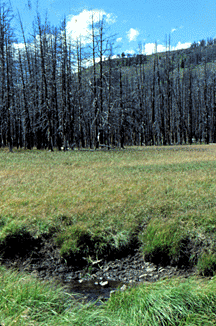 For an Easterner, whose only taste of
wilderness may be a hike through the forest not far from the main road
through a nearby state park, horsepacking through the vast wilderness of
eastern Yellowstone National Park is the adventure of a lifetime. Under
normal conditions, the landscape here borders on the spectacular, but after
the disastrous fires of 1988, it took on a ghostly aura that I won't soon
forget. For an Easterner, whose only taste of
wilderness may be a hike through the forest not far from the main road
through a nearby state park, horsepacking through the vast wilderness of
eastern Yellowstone National Park is the adventure of a lifetime. Under
normal conditions, the landscape here borders on the spectacular, but after
the disastrous fires of 1988, it took on a ghostly aura that I won't soon
forget.
Our party of 15, an assortment of experienced and relatively
inexperienced riders, began its trek in the brilliant sunshine of late
August. That first day we rode out across Pelican Valley, a broad expanse of
meadows traversed by a meandering stream stretching to Pelican Cone on the
east side of Yellowstone National Park. The cool verdant landscape, rich in
a hundred shades of green, consisted of lush soggy meadow grasses that
seemed to go on forever.
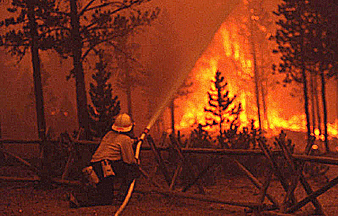 This was a far cry from the searing heat and power of the fires that
swept through this area during the late summer of 1988. Twenty-five thousand
firefighters, assisted by 4,000 U.S. military personnel, 400 fire trucks,
and 120 Chinook helicopters, all gathered to fight one of the worst fires in
the history of the West in shifts lasting as long as 14 hours. Aircraft
dropped 14 million gallons of fire retardant chemicals and 10 million
gallons of water on the flames. Crews fought through old growth, new growth
and meadow, the calico pattern left by fires of other times. This was a far cry from the searing heat and power of the fires that
swept through this area during the late summer of 1988. Twenty-five thousand
firefighters, assisted by 4,000 U.S. military personnel, 400 fire trucks,
and 120 Chinook helicopters, all gathered to fight one of the worst fires in
the history of the West in shifts lasting as long as 14 hours. Aircraft
dropped 14 million gallons of fire retardant chemicals and 10 million
gallons of water on the flames. Crews fought through old growth, new growth
and meadow, the calico pattern left by fires of other times.
The Yellowstone fires of 1988 together formed the largest wildfire in the
recorded history of Yellowstone National Park. Starting as many smaller
individual fires, the flames spread quickly out of control with increasing
winds and drought and combined into one large conflagration, as if the
Devil, himself, had unleashed a mighty firestorm upon the Earth. , On
September 8, officials closed the park to all but emergency personnel for
the first time in its history after fires nearly destroyed two major visitor
installations. Only the arrival of cool and moist weather in the late autumn
brought the fires to an end. Over 793,000 acres burned to varying degrees of
crispness. The cost of the firefighting effort soared to over $120 million.
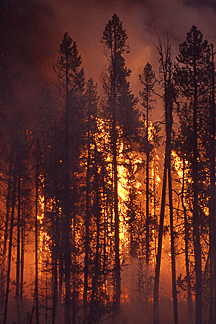 Firefighters called August 20 "Black Saturday" because of the
150,000 acres devastated by fire. In some places the smoke became so dense
it blotted out the sun. Between June and August, nearly 250 different fires,
seven of which destroyed 95 percent of the total burned area, began in
Yellowstone Park and the surrounding National Forests. Dry storms with
fierce winds and lightening merged smaller fires together. On that awesome
day, more land burned in Yellowstone Park than the combination of all the
fires since its creation. Firefighters called August 20 "Black Saturday" because of the
150,000 acres devastated by fire. In some places the smoke became so dense
it blotted out the sun. Between June and August, nearly 250 different fires,
seven of which destroyed 95 percent of the total burned area, began in
Yellowstone Park and the surrounding National Forests. Dry storms with
fierce winds and lightening merged smaller fires together. On that awesome
day, more land burned in Yellowstone Park than the combination of all the
fires since its creation.
The wind driven flames jumped roads and firelines while burning embers
started new fires a mile ahead of the main ones. What started on July 9 as
one fire along Mist Creek in the Park's Lake District in the Absaroka
Mountains eventually grew to 13 that burned until snow fell in September.
Two days after the Mist Fire began, the Clover Fire started in the same
area, eventually combining on July 20 with the first to create the mighty
Clover Mist Fire. As it burned through some of the Park’s most rugged
terrain, it became difficult for firefighters to control. Eventually, this
fire consumed over 140,000 acres.
According to fire ecologist Don Despain of the National Biological
Service, what drove the fires was a system of fire cells. "As one would
send sparks and firebrands downwind, these would ignite, starting new ones.
Burning vigorously, these new cells sucked air and flames from the parent
cell. With time and surges of wind, flame and energy traveled back and forth
among the cells driving the fire."
"Night winds were another adversary," he said. "running
from high ridges down along the river and creek drainages, cascading like
airy rapids, waking smoldering fires and bearing them downstream. Small
fuels like needles and twigs absorbed almost no moisture during nighttime
periods of higher humanity thus adding to the process. The updraft of wind
blew fire down the valleys. Whole mountains went up in flames."
All fire fighters could do was walk away. Despite their valiant efforts,
fires invaded thousands of acres in and around the world's oldest national
park.
 As a cold front moved in, the sky over Pelican Valley turned battleship
gray and grew darker with menacing clouds as lightning streaked bright white
on the horizon. Loud claps of thunder roared through the valley. Large
chunks of hail pelted us, scaring both horses and riders. We rode through
rain storms, one after another. As a cold front moved in, the sky over Pelican Valley turned battleship
gray and grew darker with menacing clouds as lightning streaked bright white
on the horizon. Loud claps of thunder roared through the valley. Large
chunks of hail pelted us, scaring both horses and riders. We rode through
rain storms, one after another.
We stopped to put our ponchos on. Everything seemed to spook the horses,
from lightning to flapping ponchos to the backpacks on passing hiker's
backs.
Lightning also ignited the great Clover-Mist Fire on Pelican Ridge, just
ahead of us. It was one of the worst days of that summer when cold fronts
came whistling through with high winds and lightning but almost no rain. A
wall of flame blazed up out of nowhere and the battle between Mother Nature
and Man had begun. Soon wind-driven fires in Yellowstone National Park and
the surrounding area advanced into 160,000 new acres, 62,000 inside the
park.
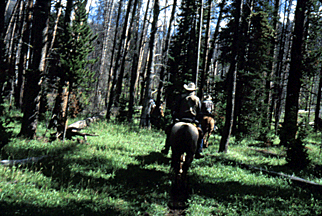 We continued on without seeking shelter until we came to a Ranger Control
Cabin for lunch. We paused briefly to eat our soggy sandwiches in the
dampness and drizzle before mounting up and heading out into the highlands. We continued on without seeking shelter until we came to a Ranger Control
Cabin for lunch. We paused briefly to eat our soggy sandwiches in the
dampness and drizzle before mounting up and heading out into the highlands.
After leaving Pelican Valley, the trail climbed sharply up the side of
Pelican Ridge, one of the places where the fires started. Known as the
Clover Fire, it would eventually merge with the Mist Creek Fire down the
valley to become one of the fiercest. Though the trail was steep, it was but
a precursor to the treacherous terrain over which we were to travel in the
days ahead. The carcasses of burned
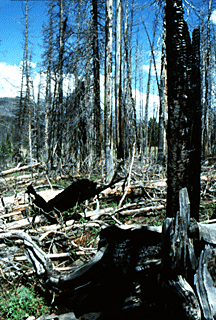 trees littered the path and the ride was
slow going. By the time we reached the top, it felt as if we had left life
as we know it and transcended into the eerie dank remains of Hell after the
fires had died out. trees littered the path and the ride was
slow going. By the time we reached the top, it felt as if we had left life
as we know it and transcended into the eerie dank remains of Hell after the
fires had died out.
The highlight of that first afternoon was the ride through the burned out
forest up through Mist Creek Pass, past hundreds of still blackened tree
trunks. Here and there saplings poked through the ashes struggling to gain a
foothold on life. Charred tree trunks lay piled like Pick-Up-Sticks as far
as the eye could see. A pall hung over the landscape. We heard nothing–no
birds, no small animals, only the whistle of the ever-chilling wind which
interrupted the sight of the landscape, a vertical blind of bright orange,
silver grey and black. And when it wasn't blowing–silence.
No one uttered a word. It was if we were traveling through a cemetery. I
could almost hear the screams of the trees as they were eaten alive by the
fire. All stood in some twisted form of perpetual agony. The wind blew
strong here, for there was nothing to break it.
Next:
Day 1
|
